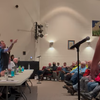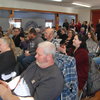Berne’s ATV bill crashes against safety guidance
BERNE — Berne’s proposal to open up several of its roads to all-terrain vehicles and other off-road machines has generated enormous controversy within the town, with residents taking to social media and the Enterprise opinion pages to speculate about the potential impact it would have on the town.
The most pressing concern is that the proposed law goes directly against guidance provided by a number of organizations, from consumer groups and state agencies to ATV safety groups and vehicle manufacturers.
In New York State, public roads are closed by default to ATVs and similar vehicles except when a rider needs to cross from one section of an off-road trail to another. Berne, however, hopes to exercise its local authority by opening up many of its own roads to ATVs so that riders can traverse the town and take advantage of any trails created by the organization Hilltown Riders on private lands.
While the law would require riders to be members of the Hilltown Riders, which has certain rules around safety such as wearing a helmet and not riding with more passengers than a vehicle allows, and to maintain certain speeds and formations on town roads, the overwhelming guidance around riding on pavement and accident statistics suggest that the practice is risky regardless of behavior.
A 2013 study by the Insurance Institute for Highway Safety, notes that more than half of ATV fatalities in 2007 occurred on a public road, and that the rate of on-road deaths increased by 284 percent from 1998 to 2007, compared to a 155 percent increase in off-road deaths.
The study found that 75 percent of fatalities from 2007 to 2011 were a single-ATV accident, meaning no other vehicles were involved, and that 31 percent of these accidents had a rollover as the “first harmful event” of the accident, while 56 percent involved a rollover at any point.
The Enterprise reported in 2009 on a fatal ATV accident in which a seventh-grader from Berne-Knox-Westerlo was killed when his vehicle turned over. He was not wearing a helmet or seatbelt, and was riding on his property, off-road.
Albany County Sheriff Craig Apple, who then was the chief deputy, told The Enterprise at the time, “This is a machine that is obviously pretty easily tipped over, so, I think it was a combination of a little too fast, no helmet and no seat belt.”
Berne’s proposed law got a thumbs-up from the Albany County Sheriff’s Office, with Commander Tom Praisner explaining at a town board meeting this past November that law enforcement is primarily concerned with safety.
The 2013 study found that the greatest share of fatal accidents in which speed could be determined — 43 percent — occurred while riders were going between 10 and 35 miles per hour, according to the study. The Berne law would have riders capped at 20 miles per hour. Also, more than half of all the accidents occurred when riders were going straight, while 27 percent occurred while they were going around a bend.
A high blood-alcohol level and lack of helmet were found in a large number of cases (43 percent and 90 percent, respectively), the study says.
The vast majority of all fatal accidents took place on roads that were designated for ATV use, the study says, drawing from police reports, but noting that the accuracy of this figure could not be verified.
A Consumer Federation of America report on ATVs states that ATVs are more likely to flip over when on pavement because “knobby, low-pressure” tires don’t make contact with pavement the way they do with rough surfaces, and because of the vehicles’ typically high center of gravity and narrow wheel base.
Because of the risk associated with on-pavement use, the United States Consumer Product Safety Commission requires ATV manufacturers to apply warning labels on their vehicles about driving on pavement, as noted in the Insurance Institute paper.
Berne Planning Board Chairman Joe Martin, who has been a leading figure in the push for ATV law since he took up the issue after, he said, ATV riders in the town expressed a desire for a trail network, declined to directly address Enterprise questions about the safety factor.
“I think there is a lot of layers to this and I look forward to hearing the people’s input at the next board meeting …,” he said. “The vast majority I feel will find compromise to respect and encourage each other to enjoy the outdoors how they see fit, respecting each other’s space.”
After being presented with the Consumer Federation report and questions about the club’s stance on riding ATVs on smooth surfaces, the Hilltown Riders said simply, “It has been our experience that off road vehicles are usually able to traverse smooth or paved surfaces.”
The sheriff’s office did not respond to an Enterprise inquiry.
Practical effect
There are also questions about how effective this law would be in turning the town into a destination for local ATV enthusiasts. Martin has said the law could bolster local businesses, erroneously connecting their health to the amount of money Berne receives in sales tax, which is doled out by the county based on population and not related to local sales.
A map highlighting the roads that would be designated ATV-friendly if the law were passed, created by The Enterprise, reveals that several roads fail to connect to other ATV-friendly roads, and that, as currently drafted, there would be no real, singular network, instead just various clusters and strands.
Several roads on the draft list provided by the town also lead into neighboring communities, and some roads — like Dutch Settlement, Udell, and Wolf Hill — are hardly in the town of Berne at all.
Others, like Merridale Lane and Mill Dam Road, are incredibly short, in addition to being disconnected.
It is possible that the roads could be connected by off-road trails if the Hilltown Riders secure enough agreements with local property owners who are willing to allow ATVs on their land.
The Hilltown Riders currently oversee two trail systems in the Capital Region, one on its own over-600-acre property in the Saratoga County town of Day, and the other on land the club leases from Camp Pinnacle, in New Scotland.



